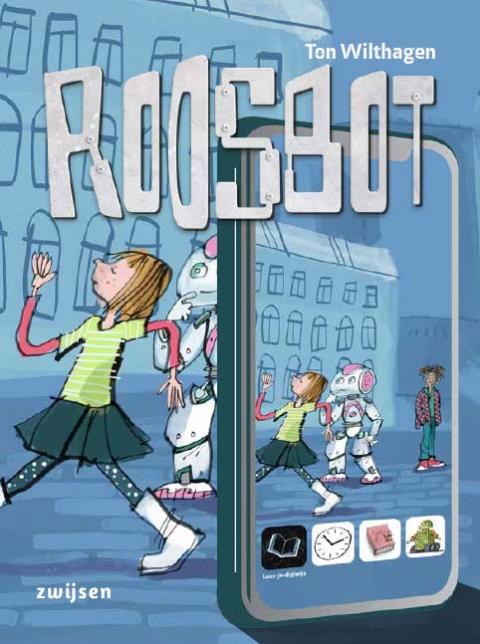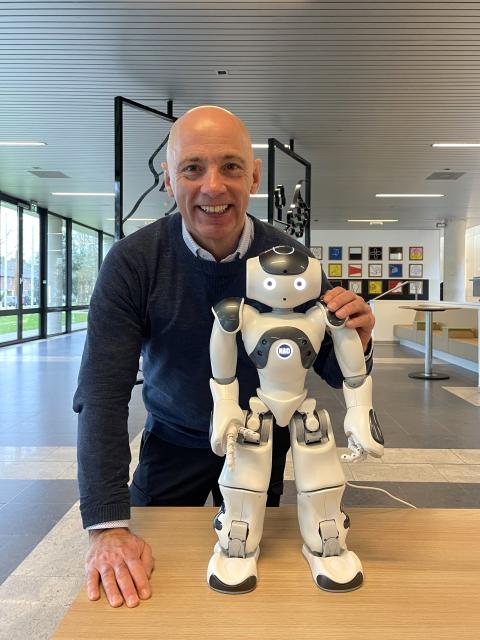Ton Wilthagen wants to give the youngest generation something real
It is not at all unusual for professors to write, but for a professor to write a children’s book, that is unusual, to say the least. Ton Wilthagen is Professor of Institutional and Legal Aspects of the Labor Market at Tilburg University, and he recently wrote Roosbot, an educational page-turner about robots for children aged 8 to 10 years. It’s a theme he also engages with in his research.
What makes a labor market professor write a children’s book about robots?
“It’s part of my academic mandate to explore the influence of robots and artificial intelligence (AI) on our work. A few years ago, I co-authored an essay (Building TrusTee) that addressed the question of how to build the most dependable robot on earth, and when we’d finished it, I wanted to learn more about what we impart to children about robots and AI. So I asked my local bookseller to put aside books on these subjects for me. And at some point everything I had learned from books for young and older children gave rise to the idea of writing a children’s book myself. Roosbot is that book.”

Can you lift a tip of the veil?
“Roosbot invites children to think about the role and value of robots in our lives. A young girl called Roos is the main character and she doesn’t understand why grown-ups treat the world and nature so carelessly. When she hears about new technology and robots and about how they make the world a better place, her response is: that is precisely what I want, too. That’s why Roos decides to become a robot: Roosbot. Without giving too much away, I can reveal that she comes to face a dilemma. She learns that technology can be both a blessing and a curse. And it’s us, human beings, who tip the balance.”
What do you hope to achieve with the book?
“I hope the book will make parents, children, and schools aware of our own values and of how we look at technology. A drone can be used to deliver medication, but also to kill people. Are we using technology to do good?”
You’re used to writing for researchers; children are an entirely different audience. How did you do that?
“I’ve been writing all my life, all the way back to short stories at primary school. When I became a father, I’d draft stories to tell to my children when they were young, and in my spare time I write song lyrics, including the lines to a Carnival song. I also author op-ed pieces for newspapers and websites. Switching between dissimilar target audiences and genres is something I find very easy to do. Also, this children’s book is about a topic that plays a prominent part in my work. The basis is the same; it’s just the form that’s different.”

I found that explaining such a complicated subject clearly to this large, young target audience wasn’t a struggle at all
Professor of Institutional and Legal Aspects of the Labor Market Ton Wilthagen
How do you make complex information about robots and AI palatable to 8-to-10-year-olds?
“By shaping it as a story. It’s a thrilling and instructive story about robotics, and I found that explaining such a complicated subject clearly to this large, young target audience wasn’t a struggle at all. And with the tremendous help of the publisher, Zwijsen, we refined the story; it is easy to read and difficult terms are explained separately.”
Where did you find the time in your busy schedule to write a book?
“In 2020 I was appointed Fellow at NIAS, the Netherlands Institute for Advanced Studies in the Humanities and Social Sciences, one of the institutes of the Royal Netherlands Academy of Arts and Sciences (KNAW). The plan was to live in Amsterdam on weekdays for five months, and I had half a mind to write the book in the evenings during that stint. The Covid-19 pandemic threw a wrench in the works, and I returned to Tilburg. I am an ambitious researcher and I felt I needed to respond to the challenges the pandemic presented. For example, one of the projects I became involved with at the time was a platform for residents of the province of North-Brabant who want to upskill, on site and from home (www.brabantleert.nl). At Christmas that year I picked up where I had left off and completed the book.”
It was also deeply rewarding, because through this book I can offer the new generation something real
How did you manage to share such a complex subject in a child-friendly and interesting way?
“Once I’d finished writing the book, I first asked Puck (11) to read it. She’s the daughter of our children’s former babysitter and she took her job of reviewing the book very seriously, meticulously answering all the questions I had given her. The publisher, the Tilburg LocHal library, and Tilburg University Junior then helped to make the book even better. One of the improvements was to add a story line. For example, in the book Roos learns what an algorithm is, but the explanation is given in box text features. So it’s a mix of entertainment and education, and I think that’s a good way to make children learn.”
It this a book befitting the university?
“Yes, it is, because the university has the ambition to direct even more attention to digitalization. And given the young target demographic, Tilburg University Junior is also closely involved because of its mission to introduce children to science. The book will be presented during the Children's University that takes place at our university. Together with Zwijsen we have designed work sheets supplementing the book that teachers can easily use in class. So not only do kids read about robots, they also do activities relating to robots. And for the university it is terrific that ideas expressed in the book have been turned into assignments that children can carry out: they learn how to think, compute, and even dance like robots. One of the assignments comes with a short video lecture that children can watch when they scan the QR code, and that code can also be found in the book.”
Is this an adventure worth repeating?
“I do feel the itch; I’ve got many ideas and I like creative projects like this one. It was also deeply rewarding, because through this book I can offer the new generation something real. An English edition would be really nice. Time will tell: it’s all about timing, momentum, and finding or creating the right circumstances.”
Date of publication: 7 April 2022
